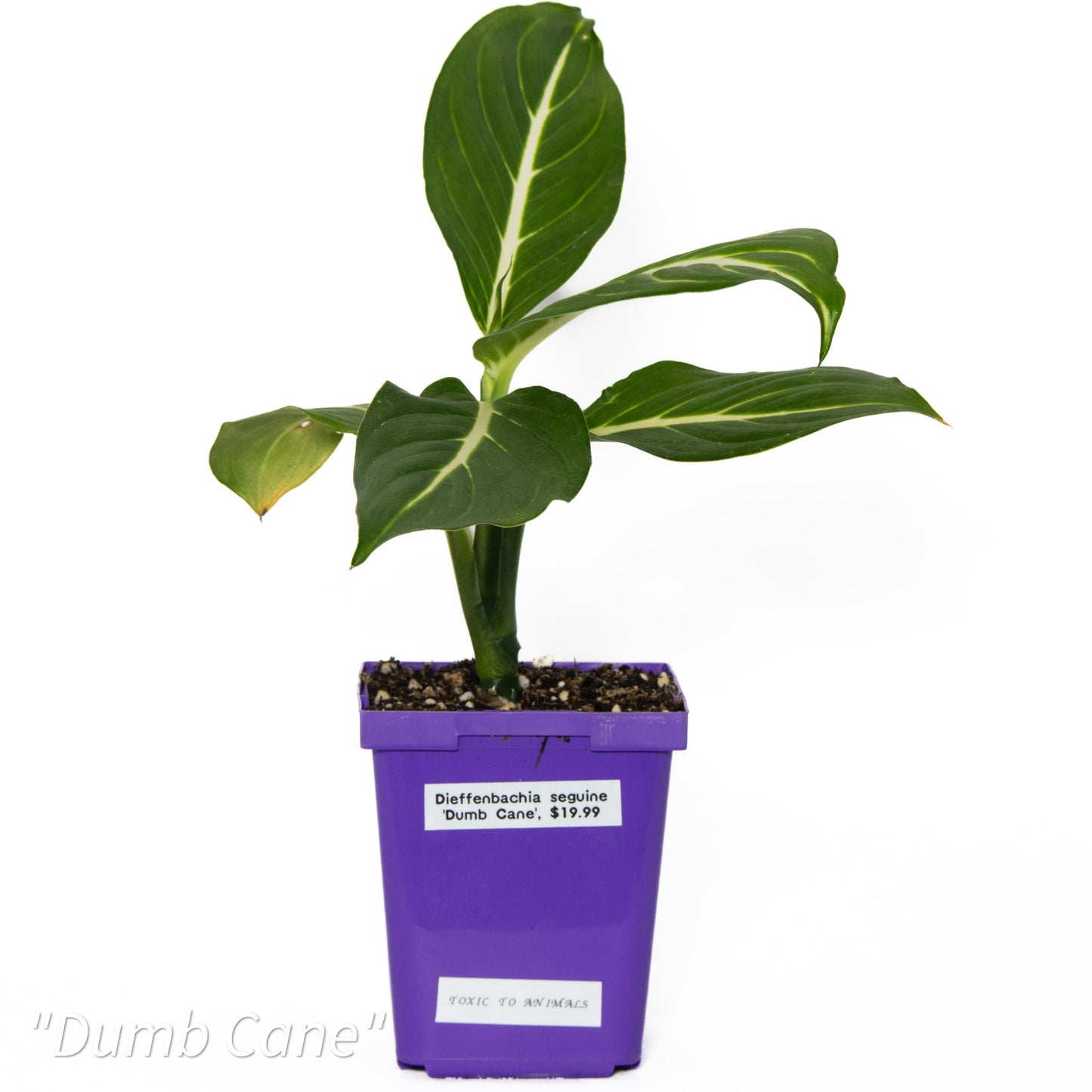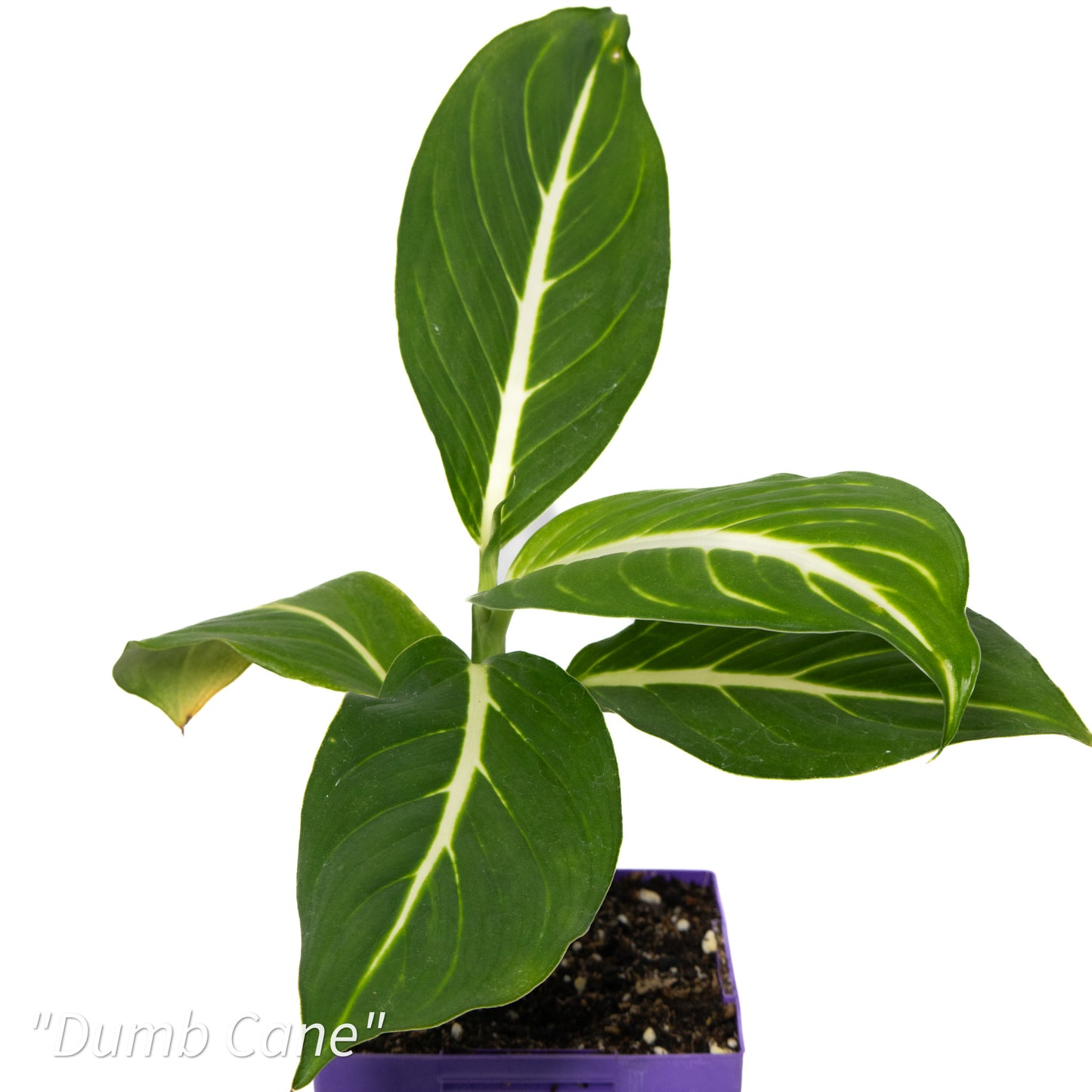Royal Python's Cove
Dieffenbachia seguine ‘Dumb Cane’
Dieffenbachia seguine ‘Dumb Cane’
Couldn't load pickup availability
Dieffenbachia seguine ‘Dumb Cane’ is a tropical, broad-leaved plant prized for its lush, variegated foliage featuring bold green, cream, and yellow patterns. It thrives in humid, warm environments, making it an excellent addition to bioactive terrariums, vivariums, or paludariums. This fast-growing plant not only enhances the aesthetic of enclosures but also provides natural cover for small reptiles and amphibians. However, caution is needed as its sap is toxic if ingested by humans and animals.
Care Instructions
LIGHT. Prefers bright, indirect light but can tolerate low-light conditions. Too much direct sunlight can cause leaf scorch, while too little light may result in leggy growth. In a bioactive setup, place it near a plant light or UVB source while ensuring it is shielded from harsh rays.
SOIL. Thrives in a well-draining, moisture-retentive soil mix. A blend of coconut coir, perlite, and orchid bark provides the right aeration and structure. In bioactive setups, this substrate will support root health and create an ideal environment for isopods and springtails.
WATERING. Keep the soil consistently moist but not soggy. Allow the top inch to dry out between waterings to prevent root rot. In bioactive enclosures, springtails and isopods will assist in breaking down excess moisture and organic matter, maintaining a balanced ecosystem.
HUMIDITY. Prefers high humidity (60-80%), making it ideal for tropical bioactive setups. If humidity levels drop too low, leaf edges may brown. Misting the enclosure or adding a shallow water dish can help maintain adequate moisture.
TEMPERATURE. Thrives in warm temperatures between 65°F and 85°F (18°C to 29°C). It is sensitive to cold and should be kept away from drafts, AC vents, and temperatures below 55°F (13°C), which can cause leaf damage.
FERTILIZATION. During the growing season (spring and summer), feed with a balanced liquid fertilizer every 4-6 weeks to promote lush growth. In bioactive setups, using Mealworm Frass provides a slow-release, organic nutrient boost for sustained health. Reduce feeding in winter when growth slows.
Cohabitation with Bioactive Organisms
ISOPODS. These beneficial decomposers help aerate the substrate, break down plant debris, and recycle nutrients to support Dieffenbachia’s growth.
SPRINGTAILS. Essential for preventing fungal growth and mold, springtails maintain soil health by consuming decaying organic material, reducing the risk of root rot in humid environments.
Soil and Maintenance Tips
SUBSTRATE. A well-draining mix of coconut coir, perlite, and orchid bark prevents compaction and supports strong root development. Adding a layer of activated charcoal at the bottom of the setup can improve air circulation and odor control.
HUMIDITY CONTROL. In a bioactive setup, humidity can be maintained by misting, using a shallow water dish, or incorporating a moisture-retaining substrate. Springtails will help regulate excess moisture to prevent mold issues.
TRIMMING. Trim damaged or yellowing leaves regularly to encourage new, healthy growth. Pruning also helps maintain a compact shape, especially in enclosed setups.
PEST CONTROL. While Dieffenbachia is naturally pest-resistant, watch for spider mites, aphids, and mealybugs in drier conditions. In bioactive enclosures, isopods and springtails will help prevent infestations by feeding on pest eggs and decaying organic matter.
With its stunning, variegated foliage and low-maintenance nature, Dieffenbachia seguine ‘Dumb Cane’ is an excellent choice for bioactive environments. It thrives alongside isopods and springtails, contributing to a self-sustaining, humid ecosystem. By ensuring consistent moisture, proper lighting, and warm temperatures, this tropical beauty will flourish in your enclosure, providing vibrant greenery and natural shelter for inhabitants.
Share




